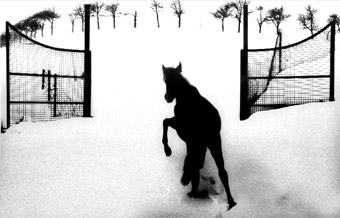every moment lived, a moment lost
dan edwards encounters kiarostami’s photography in beijing

Abbas Kiarostami
ABBAS KIAROSTAMI IS MOST FAMOUS AS A FILM DIRECTOR, BUT HIS ARTISTIC OEUVRE EXTENDS FAR BEYOND THE SCREEN. HE HAS WORKED EXTENSIVELY IN BOTH VIDEO AND PHOTOGRAPHY, BUT MOST IMPORTANTLY HE IS A POET—LITERALLY IN THE SENSE OF HAVING PUBLISHED POETRY, FIGURATIVELY IN THAT A POETIC SENSIBILITY INFORMS ALL HIS WORK. IN HIS FILMS AND PHOTOGRAPHY, THIS SENSIBILITY IS OFTEN EXPRESSED THROUGH A SIMULTANEOUS REFLECTION UPON WHAT IS SEEN—THE IMAGE’S CONTENT—AND THE NATURE OF THE IMAGE ITSELF. THE CINEMATIC FRUITS OF THIS APPROACH ARE RICHLY EVIDENT IN KIAROSTAMI’S FILMS, BUT AUDIENCES IN BEIJING RECENTLY HAD A CHANCE TO APPRECIATE HIS LESSER SHOWN PHOTOGRAPHY WITH AN EXHIBITION OF STUNNING BLACK AND WHITE LANDSCAPES.
The exhibition fell roughly into two halves, with all the images in high contrast black and white. The first comprised a series of roads winding across otherwise untouched landscapes. The second was a collection of natural scenes covered in thick snow. But as is often the case with Kiarostami’s cinema, this basic description of seemingly prosaic content fails to convey the effect of his work’s rich multi-layering.
Kiarostami has long had an obsession with road trips, from the protracted meandering through Iran’s parched countryside in A Taste of Cherry (1997) to the endless dissections of Tehran in Ten (2002). But his filmic journeys are never straightforward linear progressions, nor do they ever reach any conclusive endpoint. Similarly, the roads in his photographs trace twisted paths across uneven, mountainous terrains, disappearing around bends or over the horizon before reaching any destination. The images capture the coarse surface of the rugged landscapes in fine detail, but it’s impossible to tell if the soil is covered in grass or is simply mottled clay baked dry by the sun. The absence of colour reduces everything to pure texture, tactile yet barren, despite the frequent presence of lone trees. One image features a structure lost in the undulating terrain; a small, crumbling edifice gradually being absorbed by the surrounding hills.
Kiarostami creates a tension between the twisted forward momentum implied by the roads and the sense of quiet stasis emanating from the landscapes. But even the sense of movement in the roads feels strangely ossified; rather than holding the promise of progress and change, the deserted byways look more like markers of journeys past—transitory passages lost to time. The impression is bolstered by the fact that many are little more than dirt tracks. Even when they are modern blacktops, the absence of traffic makes them look like the abandoned remnants of a lost civilization rather than functioning highways.
Kiarostami’s snowscapes exude a similarly ghostly atmosphere, though unlike the road shots most contain obvious signs of life. In one image of a snow-covered mountain range, for example, a large flock of birds flies across the foreground. However, Kiarostami’s use of extreme high contrast reduces the birds to black holes winging their way across mountain-shaped expanses of white. The presence of life is expressed as a kind of absence—a shadow left the in wake of a fleeting moment. Many of the snowscapes have the same effect. The most striking example is a horse reduced to a featureless silhouette, struggling through thick snow.
One image in particular is emblematic of Kiarostami’s approach in this series of photographs. A tree trunk in close-up—again rendered in pure black—is surrounded by a field of virgin snow. Behind, the tree’s stark shadow falls across the white landscape. Tree and shadow blend into one, blurring the line between solid object and the intangible play of light.
There’s a subtle reflexivity at work here. The photographs evacuate their natural scenes of movement and life, leaving only a frozen, blank vacuum. The silhouettes don’t imply the snapshot immediacy of movement caught on the fly, but rather impressions of life left after life itself has moved on, like frozen footprints left in the snow. This is photography as a kind of ghosting, the spectral image left in life’s wake.
A single video installation in a corner of the gallery complements and extends these complex thematic concerns. Titled Ten Minutes Older, it’s a 10-minute video, shown in a continuous loop, of a toddler sleeping. Projected from the ceiling onto the floor at actual size, it gives the boy an unnervingly lifelike appearance. He twitches, smiles, dreams, rolls over and finally wakes and begins to cry before the image fades to black. A small slice of a child’s life forever replayed in the present, utilising video as a medium that both reanimates the past and locks it into a sequence of never-changing movements.
In an era characterised by a cacophony of live news clips and advertising images that render the world in an eternal present, Kiarostami’s work reminds us that film and photography offer other possibilities. His images prompt us to reflect upon the relationship of these mediums to the transience of experience and, by extension, our own mortality. With a sharp poignancy, these works remind us that every moment lived is a moment lost, and that for every one of us these moments will eventually cease, leaving behind only lifeless, fading images.
Appropriately for an exhibition so concerned with time, Kiarostami’s work was exhibited in the new contemporary wing of the Beijing Art Museum of the Imperial City, nestled snugly against the ancient walls of the Forbidden City. The museum formerly held a rarely visited collection of antique artefacts, but the space has recently been taken over by private firm, Zenith Culture International. Their creation of a contemporary wing—unveiled with the Kiarostami exhibition—signals an exciting addition to Beijing’s rapidly evolving cultural landscape.
Abbas Kiarostami solo exhibition, curators Shi Li-Sanderson and Cui Qiao, Beijing Art Museum of the Imperial City (BAMOIC), People’s Republic of China, Jan 26-March 6
RealTime issue #84 April-May 2008 pg. 24






